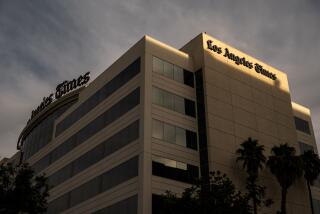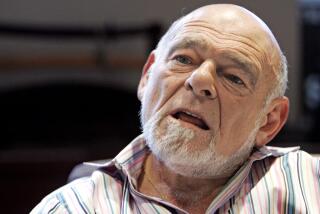THE PAPER: The Life and Death of THE NEW YORK HERALD TRIBUNE <i> by Richard Kluger (Knopf: $24.95; 801 pp., illustrated)</i>
- Share via
In 1946, at the end of World War II, in the heyday of print journalism, there were 1,763 daily newspapers being published across the United States, 11 in the New York metropolitan area. Today, New York is down to five papers with no real head-to-head competition, and a far more populous United States is down to 1,674 dailies, 70% of them now owned by the big multicity newspaper chains. Competitive journalism has been eliminated for all but about three dozen newspapers.
Of all the papers that have disappeared from the American scene, the only one that could possibly justify a posthumous book about the vivid, boisterous, creative life and times of another era is the New York Herald Tribune, which went under in 1966.
Richard Kluger, the paper’s book editor for the last four years of its life, has performed a vast labor of love and research on 131 years of Herald Tribune history, written with verve, style and skill. For myself, a veteran of 23 years on the Herald Tribune through the best of times and the worst of times, reading Kluger was like walking into that grubby old city room once again with its clattering Underwood typewriters, or drinking with old friends at the bar of Jack Bleeck’s, 10 yards from the rear door on 40th Street.
But happily, this is not just a book of nostalgic fluff for old newspaper buffs. It is an absorbing, serious and colorful picture of social, political and journalistic life in an era when newspapers across America were family businesses, and reporters and writers were the television of the times because there was no television. Almost every city of any size had competing daily papers. Ownership automatically endowed any publisher, good or bad, with prestige and power that he could never enjoy by selling automobiles or getting elected mayor.
The Reid family, which acquired the New York Tribune in 1874 and added the Herald in 1923, were wealthy enough to regard their newspaper most of its life more or less as J. P. Morgan spoke of his yacht: “If you have to ask how much it costs, you can’t afford one.” The Herald Tribune seldom made money until its halcyon days during World War II and the immediate postwar years, and the Reids were benevolent despots--rather more benevolent than despotic. Secure in their own wealth and social prestige, they were lax in business acumen and failed to see the need to invest in their paper the way the rival owners of The New York Times were investing and pushing ahead.
But if the business management of the Herald Tribune under the Reids for about 80 years varied from short-sighted to inept, the editorial product over which they presided was quite simply the most sparkling high-quality paper in the history of American journalism. At its best, the paper had the best of everything--the best city editors in Stanley Walker and L. L. Engleking, the best sports editor in Stanley Woodward, the best foreign editor in Joseph Barnes, the best music, theater and arts critics, the best sports columnist in Red Smith, the best political commentators lead by Walter Lippmann, the best editorial writers, city reporters, Washington bureau, war correspondents, rewrite men, news editors, copy readers and fortunately or unfortunately, some of the best drinkers in New York, including the publisher himself, dignified and somewhat dotty Ogden Reid.
Good writing, tight writing, individual style and detached laconic humor typified the Herald Tribune at its best. It was the quality of its editing as much as verve of its reporters that enabled Herald Tribune men to out-write the competition. The standards were high, untilcheapened in the paper’s erratic last years.
So what went wrong, how and when did the rot set in? I suppose the turning-point came after the war in 1947 when costs once again began to out-race substantial profits, and Ogden Reid, in one of his last decisions before he died, felt confident enough in the paper’s quality and prestige to raise the price from 3 cents to a nickel. He expected The New York Times to follow, but instead, it held at 3 cents for nearly two years, and the circulation gap widened, and the death of a thousand cuts began.
For the next 10 years, Ogden’s sons fumbled and fiddled. Kluger aptly quotes a Tribune veteran, “Whitelaw Reid didn’t know how to make decisions, and Brownie (his younger brother, Ogden Jr.) didn’t know how to make any right decisions.” They tried puzzle contests, the last refuge of hapless circulation managers, green-sheet editions, red-baiting sensationalism that failed along with Sen. McCarthy, and of course cuts and more cuts.
By the time the elegant, sensible and eminently suitable multimillionaire John Hay Whitney took over as the paper’s last owner, a kind of newspaper arteriosclerosis was setting in. There were merciless labor strikes, and advertisers decided they no longer needed the Herald Tribune’s fading circulation alongside the Times.
Whitney’s first choice as editor, plucked from a small-town Kansas paper, was hopelessly under-equipped for the challenge. John Denson, who took over next, was viewed by some as a mad genius, by others as simply mad. With hyped headlines and typographic spectaculars each morning, Denson inflated the circulation while emasculating the content. In recounting the brief Denson “success,” I think Kluger misses the essential of Denson’s destruction of the paper’s most precious ingredient, its integrity.
Walter Lippmann was the most notable byline among the top writers and reporters who walked out or were driven out during the Denson era simply because they did not want to be associated with the paper any longer. Whitney poured $40 million into the Herald Tribune. It was not too little, it was simply too late.
When a reporter once asked a Herald Tribune news editor how long his story could run in the paper’s notoriously tight space, he got the gruff and eminently sound reply: “Write until it gets dull.” Kluger has written an 800-page book, and it does not get dull. A legendary Herald Tribune rewrite man for nearly 40 years, M. C. “Inky” Blackman once said that the difference between an obituary in the Herald Tribune and one in The New York Times was that in the Times a man simply died, while in the Herald Tribune he once lived.
In Kluger’s warm, witty, wonderful obituary, the Trib still lives.
More to Read
Sign up for Essential California
The most important California stories and recommendations in your inbox every morning.
You may occasionally receive promotional content from the Los Angeles Times.













